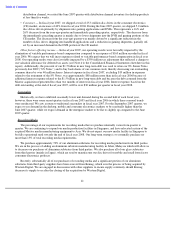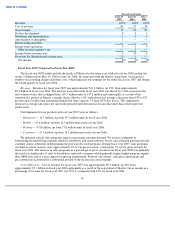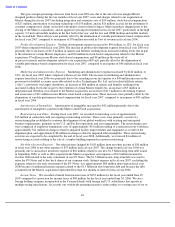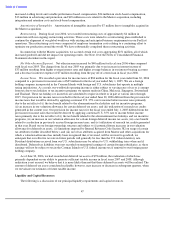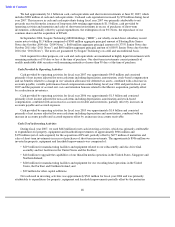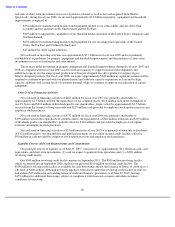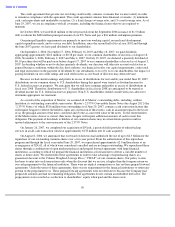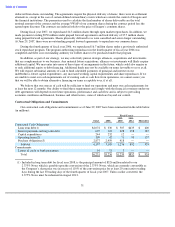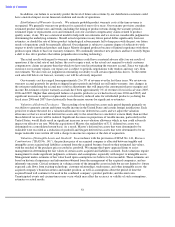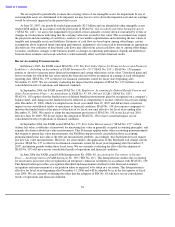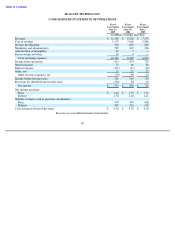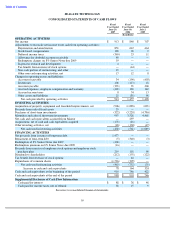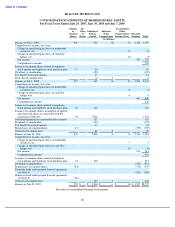Seagate 2006 Annual Report Download - page 53
Download and view the complete annual report
Please find page 53 of the 2006 Seagate annual report below. You can navigate through the pages in the report by either clicking on the pages listed below, or by using the keyword search tool below to find specific information within the annual report.
Table of Contents
The credit agreement that governs our revolving credit facility contains covenants that we must satisfy in order
to remain in compliance with the agreement. This credit agreement contains three financial covenants: (1) minimum
cash, cash equivalents and marketable securities; (2) a fixed charge coverage ratio; and (3) a net leverage ratio. As of
June 29, 2007, we are in compliance with all covenants, including the financial ratios that we are required to
maintain.
In October 2006, we used $416 million of the net proceeds from the September 2006 issuance of $1.5 billion
debt to redeem the $400 million principal amount of our 8% Notes and pay a $16 million redemption premium.
Our principal liquidity requirements are primarily to meet our working capital, research and development,
capital expenditure needs, and to service our debt. In addition, since the second half of fiscal year 2002 and through
the June 2007 quarter, we have paid dividends to our shareholders.
On September 1, 2006, November 17, 2006, February 16, 2007 and May 18, 2007, we paid dividends
aggregating approximately $212 million, or $0.38 per share, to our common shareholders of record as of August 18,
2006, November 3, 2006, February 2, 2007 and May 4, 2007. On July 19, 2007, we declared a quarterly dividend of
$0.10 per share that will be paid on or before August 17, 2007 to our common shareholders of record as of August 3,
2007. In deciding whether or not to declare quarterly dividends, our directors will take into account such factors as
general business conditions within the disc drive industry, our financial results, our capital requirements, contractual
and legal restrictions on the payment of dividends by our subsidiaries to us or by us to our shareholders, the impact of
paying dividends on our credit ratings and such other factors as our board of directors may deem relevant.
Because we had current earnings and profits in excess of distributions for our taxable year ended June 29, 2007,
distributions on our common shares to U.S. shareholders during this period were treated as dividend income for
U.S. federal income tax purposes. We anticipate that we will have earnings and profits in excess of distributions in
fiscal year 2008. Therefore, distributions to U.S. shareholders in fiscal year 2008 are anticipated to be treated as
dividend income for U.S. federal income tax purposes. Non-U.S. shareholders should consult with a tax advisor to
determine appropriate tax treatment.
As a result of the acquisition of Maxtor, we assumed all of Maxtor’s outstanding debts, including, without
limitation, its outstanding convertible senior notes. Maxtor’s 2.375% Convertible Senior Notes due August 2012 (the
“2.375% Notes), of which $326 million were outstanding as of June 29, 2007, contain a cash conversion feature that
will require Seagate to deliver the holders, upon any conversion of these notes, cash in an amount equal to the lesser
of (a) the principal amount of the notes converted and (b) the as-converted value of the notes. To the extent holders
of the Maxtor notes choose to convert their notes, Seagate will require additional amounts of cash to meet this
obligation. The payment of dividends to holders of our common shares may in certain future quarters result in
upward adjustments to the conversion rate of the 2.375% Notes.
On January 26, 2007, we completed our acquisition of EVault, a privately held provider of online backup
services in an all cash transaction valued at approximately $178 million (net of cash acquired).
On August 8, 2006, we announced that our board of directors had authorized the use of up to $2.5 billion for the
repurchase of our outstanding common shares over a two-year period. From the authorization of this repurchase
program and through the fiscal year ended June 29, 2007, we repurchased approximately 62.0 million shares at an
average price of $24.62, all of which were considered cancelled and are no longer outstanding. We repurchased these
shares through a combination of open market purchases and prepaid forward agreements with large financial
institutions, according to which we prepaid the financial institutions a fixed amount to deliver a variable number of
shares at future dates. We entered into these agreements in order to take advantage of repurchasing shares at a
guaranteed discount to the Volume Weighted Average Price (“VWAP”) of our common shares. Our policy to date
has been to enter into such transactions only when the discount that we receive is higher than the foregone return on
our cash prepayment to the financial institution. There were no explicit commissions or fees on these prepaid forward
agreements. Under the terms of these agreements, there was no requirement for the financial institutions to return any
portion of the prepayment to us. These prepaid forward agreements were not derivatives because the Company had
prepaid all amounts and had no remaining obligation. The agreements do not contain an embedded derivative. The
prepayments were recorded as a reduction to shareholders’ equity when paid and the shares were
50



